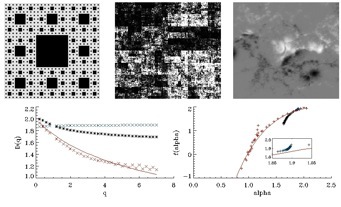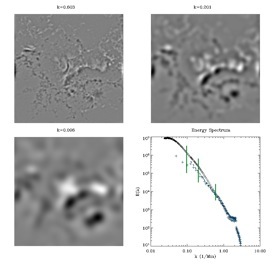
Space weather monitoring
As a Max Millennium Chief Observer I act to predict solar activity to encourage joint international observations of flares across multiple ground- and space-based observatories. To enhance our predictive capability, I adapted automated feature extraction techniques to study the magnetic field complexity of active regions on the Sun and studied their fractal nature as a function of flaring activity over the last solar cycle. As a co-supervisor of a PhD student at TCD I am currently expanding this study into the area of multifractals. This physically motivated measure has its origins in thermodynamics as the energy spectrum was conceived by Kolmogorov to study turbulence. Large, flare-productive, active regions tend to have a wider multifractal spectrum, and steeper energy spectrum

I am also working with mathematicians in Centre de Saclay, France and University of Maine, USA, in adopting these algorithms for automated use. This will require high performance computing task farming,

Using a complete solar cycle database of solar flare times and locations, it is possible to extract a probability distribution of a flare to come from any current active region on the solar disk. This method of flare prediction relies on flare waiting times following a Poisson distribution and demands a large homogenous dataset only possible from automated studies of complete solar cycles. I will combine all our previous knowledge of flare prediction to greatly enhance this vital area of space weather, where we may only have a few minutes warning of an earth directed event. In comparison, although coronal mass ejections are more geo-effective, the travel time is considerably larger (2-4 days) giving us more warning of earth directed events. For these events, I have implemented advance multiscale image processing algorithms to track their propagation in three spatial dimensions, dramatically reducing the error in predicting their path through the solar system. Solarmonitor.org, managed by the solar group at TCD, is already at the forefront of solar weather monitoring.
A vital aspect of this work is to investigate the role of the Sun in climate forcing on earth. Since Carrington first suggested that high energy particles could effect the Earth, and Maunder linked the absence of sunspots to the mini-ice age in the 17th century, this Sun-Earth connection has remained a controversial area. While recent studies show that mankind has been the main contributor to climate change this century, there is no doubt the Sun has played a role in the changing climate in the millennia before this. A direct comparison of the solar wind speed and the 11-year activity cycle to correlated activity on the ground (primarily ice core drills and tree ring growth) is used to infer the role the Sun has played on the emergence and evolution of life on Earth, as well as the potential for life on other planets in our solar system and around other stars.
